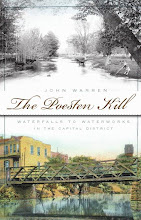 Noted local historical archeologist David R. Starbuck has said that the interconnected routes from the Richelieu River at the north end of Lake Champlain to Albany has the highest density of military sites in North America in the 1700s. The large military encampments that attended the big campaigns of that era were among the largest cities in America, albeit for short intervals. Considering the conflicts between the colonial Dutch, French, and British subjects and various Indian communities who utilized the same route, we might also extend that idea. It’s likely that the great northern route, the great warpath, the great northern war trail, and its connected communities and strategic sites have the highest density of military conflict sites in North America in the 1600s as well. It was along this route that scattered attacks by the French and their Indian allies (mostly Algonquin, Abenaki, Huron, and Christianized Iroquois) were made on the settlers along the Hudson and tributaries like the Poesten Kill.
Noted local historical archeologist David R. Starbuck has said that the interconnected routes from the Richelieu River at the north end of Lake Champlain to Albany has the highest density of military sites in North America in the 1700s. The large military encampments that attended the big campaigns of that era were among the largest cities in America, albeit for short intervals. Considering the conflicts between the colonial Dutch, French, and British subjects and various Indian communities who utilized the same route, we might also extend that idea. It’s likely that the great northern route, the great warpath, the great northern war trail, and its connected communities and strategic sites have the highest density of military conflict sites in North America in the 1600s as well. It was along this route that scattered attacks by the French and their Indian allies (mostly Algonquin, Abenaki, Huron, and Christianized Iroquois) were made on the settlers along the Hudson and tributaries like the Poesten Kill.
No palisade is known to have built at Troy, however, and according to Janny Venema, a wall around Beverwijck (outside Fort Orange) served to allay the fears of the village’s residents, but also restricted their movement outside its gates. Villagers were prohibited from leaving the palisade to meet with the Indians outside in 1660, and in 1662 posts were set up outside the community beyond which no Bevewijck residents was allowed to go. “Waiting at the post for Indians coming from the west had become a way to take a chance on luck and speculation,” Venema writes, “the defense separated the worlds of settlers and Indians, but the west [and we might add here the north at the Poesten Kill] remained an area of attraction for the colonists… a way to circumvent the rules.” Settlers used the trail to Schenectady (established in 1661, the year before Wemp secured his patent there) for illegal trade. “Despite the prohibition on trade with the Indians” Venema writes “settlers carried goods and merchandise on wagons and horseback six or seven miles inland in order to barter with the Indians… but this journey would become increasingly dangerous; and by the summer of 1664, few people dared to travel the [Mohawk] trail anymore.” Those on the Hudson’s east side at the Poesten Kill were freer to come and go as they pleased. Out of sight of local officials they could more easily participate in the trade, but also were more exposed when depredations did occur.
Monday, September 7, 2009
Settler Fears of Indian Conflict on The Upper Hudson
Labels:
Beverwijck,
Fort Orange,
Native Americans
Subscribe to:
Post Comments (Atom)

No comments:
Post a Comment